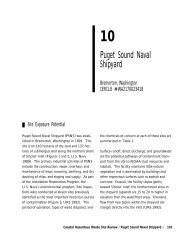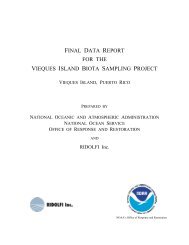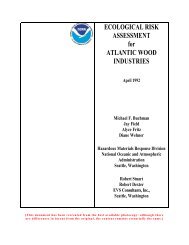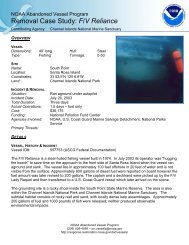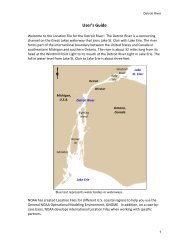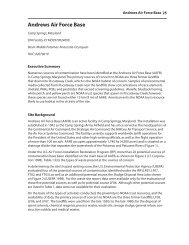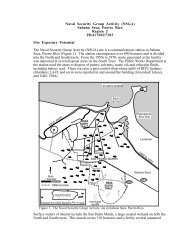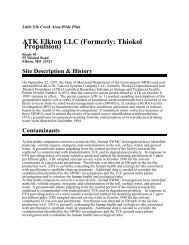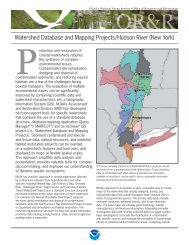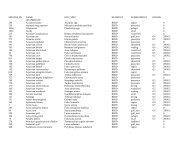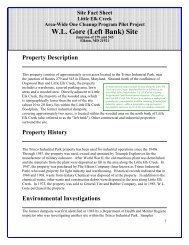The Coastal Resource Coordinator's Bioassessment Manual
The Coastal Resource Coordinator's Bioassessment Manual
The Coastal Resource Coordinator's Bioassessment Manual
You also want an ePaper? Increase the reach of your titles
YUMPU automatically turns print PDFs into web optimized ePapers that Google loves.
HAZMAT 93-1–Bioaccumulation<br />
do not measure the level of contaminants that are available through active uptake<br />
mechanisms and through the ingestion of particulates, sediments, and food. Particulates<br />
and sediments may be significant sources of contaminants for filter and deposit feeders,<br />
respectively. Also, food is a particularly important source for those contaminants that<br />
biomagnify. <strong>The</strong>refore, it must be kept in mind that artificial organisms are just simplified<br />
models of real organisms and, as such, are not able to indicate exactly what real organisms<br />
accumulate.<br />
Test Organism Selection<br />
<strong>The</strong> selection of an appropriate organism, whether indigenous or transplanted, for a<br />
bioaccumulation study is extremely important. Table 4-3 gives a list of criteria that should<br />
be considered when selecting an organism for a bioaccumulation study. <strong>The</strong> ideal organism<br />
should meet all of these criteria, but since bioaccumulation studies are conducted in the real<br />
world, that organism doesn't exist. Possibly the two most important criteria are numbers 1<br />
and 8. <strong>The</strong> test organism should be able to tolerate the expected levels of contamination<br />
without any significant changes in its viability, including changes in its metabolic rate. Any<br />
such changes may reduce the bioaccumulation rate. <strong>The</strong> organism should also concentrate<br />
the contaminant or contaminants of concern. For example, while leeches meet most of the<br />
selection criteria, they would be a poor choice of organism for PCB studies because they do<br />
not accumulate organochlorides (Environment Ontario, 1988).<br />
Sedentary organisms are preferred (criterion 2) because they can be associated with a<br />
specific location and the bioaccumulation data can be related to sediment chemistry. If<br />
biomagnification or routes of human exposure are of concern, then non-sedentary<br />
organisms from higher trophic levels might be preferable. However, it is difficult to<br />
associate non-sedentary organisms (e.g., fish) with specific locations and thus specific levels<br />
or sources of contamination. If they are used, then this lack of precision should be noted.<br />
<strong>The</strong> organism needs to be hardy enough (criterion 7) to transport to and survive in a<br />
laboratory in case depuration before analysis is necessary; this is particularly true of deposit<br />
feeders whose gut content could be a significant proportion of total body concentration of a<br />
contaminant (Chapman, 1985). In the case of transplant organisms, they need to be hardy<br />
enough to survive collecting, handling, and caging. Some organisms actively regulate levels<br />
of certain contaminants, especially those that are also essential micronutrients. This<br />
regulation can confound the correlation between organismal and water concentrations<br />
(criterion 9). For example, Cu is regulated by mussels, and, therefore mussels are not a good<br />
indicator of its bioavailability (Phillips, 1977).<br />
4-7 November 1992




